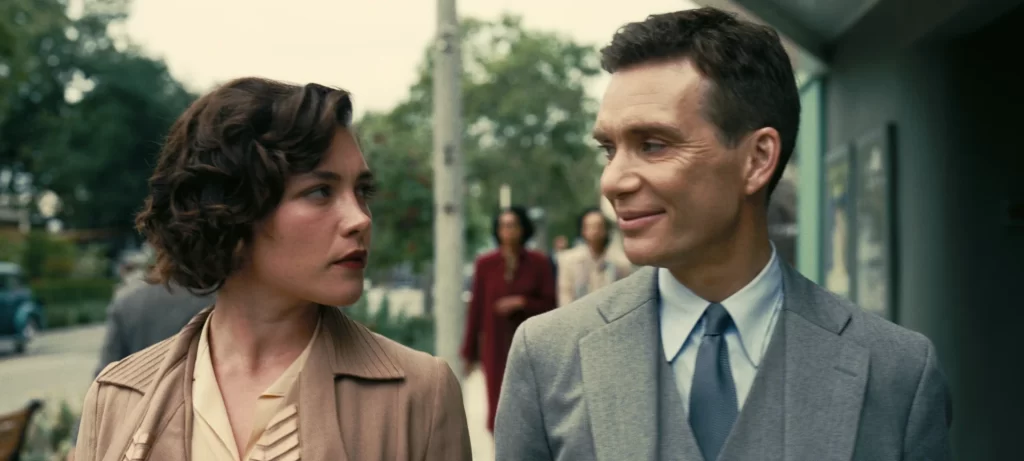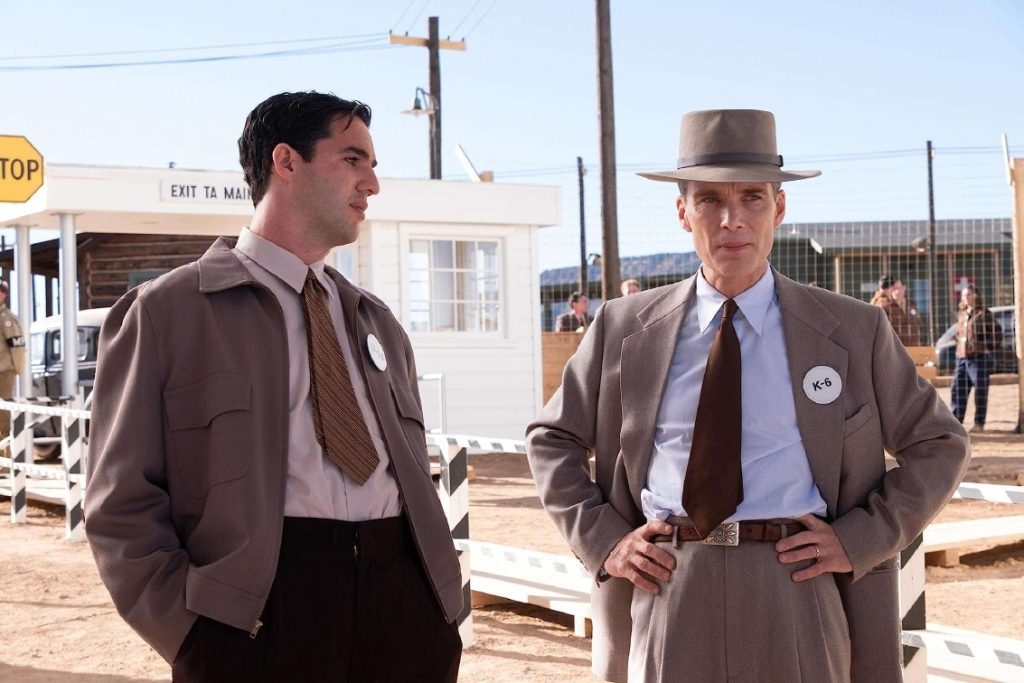
Oppenheimer review: Breathtaking visuals, enigmatic Murphy make for a flawed yet thrilling fare

“Oppenheimer couldn’t run a hamburger stand”, says Colonel Groves (played by a stern-looking Matt Damon). “I couldn’t. But I can build an atomic bomb,” retorts Oppenheimer (played by an effervescent, yet restrained Cillian Murphy).
On the surface, Oppenheimer, the film, appears to be a celebration of yet another tortured White male, one whose invention ruined generations of Japanese in Hiroshima and Nagasaki, many of whom are still living with the ill-effects of the radiation. Nolan, being the great filmmaker that he is, not only hurriedly glosses over the sheer devastation caused by Oppenheimer’s creation, he almost minimizes it.
However, the film shows Oppenheimer’s internal struggle with the idea that he has potentially created a weapon that can destroy the world. This struggle, on some level, humanizes him. After Oppenheimer is declared a war hero, he comes out to deliver a speech to the people celebrating Hiroshima and Nagasaki bombings.
Also read: Mission: Impossible – Dead Reckoning, Part 1 review: Tom Cruise revs up adrenaline overload
A powerful beam of white light, similar to the one released in nuclear fission, fills up the room. Oppenheimer begins hallucinating — he sees a woman whose skin is peeled off by the radiation. When he tries to leave the room, his feet sink into a dead human body which has turned black due to the radiation.
Oppenheimer: The destroyer of worlds
As he moves out of the room, he sees a couple mourning their child who died due to radiation. In another scene, we see horrific images of Hiroshima victims being projected on a scene. Oppenheimer cannot look at those images. He cannot look the devastation he caused in the eye.
Interestingly, the viewer doesn’t get to see those images either. Oppenheimer is clearly beating himself up — he is guilt-ridden and overwhelmed with regret. In fact, during the trial that follows, he is willing to indict himself to atone for what he did.

However, despite a stirring portrayal of Oppenheimer’s struggle, Oppenheimer, the film, cannot escape the trappings of glorifying a tortured White man. Not that Oppenheimer was good to his wife or kid either. In most scenes, Oppenheimer and Kitty’s (Katherine Oppenheimer, played by Emily Blunt) son is crying. He clearly doesn’t have loving parents. At one point, Oppenheimer hands his kid over to Haakon Chevalier because, apparently, he is too passionate about Physics to care for his kid.
Does Nolan hold Oppenheimer accountable?
However, the most brutal of all, is how Oppenheimer shamelessly betrayed Jean Tatlock (Florence Pugh), a communist, who wants Oppenheimer to send funds to the Spanish war. Oppenheimer doesn’t think twice before cheating on his wife, Kitty, and meets Jean, who is heartbroken that Oppenheimer has married Kitty. It would be safe to say that Oppenheimer abetted Jean’s suicide.
Also read: Who was Oppenheimer? Read about genius scientist, a bundle of contradictions
When he tears up thinking about Jean, Kitty tells him, “You don’t get to commit the sin and make us feel sorry for you when you face the consequences”. It is a very telling moment of how male geniuses often think they are saving the world and any damage caused by them is collateral. But when they face the consequences of their actions, they throw a fit, sit down under a tree, cry and expect the wife who they cheated on, to comfort them.
Is Nolan celebrating Oppenheimer as a genius or calling out his problematic actions? That is a thought viewers grapple with long after leaving the theater.
Less history, more courtroom drama
As a film, Oppenheimer comes off more as a historical drama than a biography. Be warned, if you are expecting to see stunning visuals of atoms and nuclei, you will only get split second visuals similar to the ones seen in the trailer. The visuals, though short, are nothing short of breathtaking. At one point, it becomes difficult to follow the film since it alternates between many timelines — some coloured, others black and white.
Half of Hollywood is in the film — after the first three cameos, you might find yourself thinking which white male scientist might show up on the screen next. Speaking of which, the film clearly doesn’t have a diverse cast. There is only a token female scientist in Oppenheimer’s team, about whom we know next to nothing. Even in the scene where Oppenheimer has visions of nuclear radiation, the victims are not Japanese but white people.
Much of the second half is spent in Oppenheimer’s security hearing where he is sabotaged by a mean-spirited Strauss who harbours animosity towards the nuclear maven. Robert Downey Jr. plays Lewis Strauss, the perfect antagonist, whose snarky look is further embellished with a grumpy face. Rami Malek as Dr David Hill is an absolute scene stealer in courtroom scenes. He testifies in the court in favour of Oppenheimer and sabotages Strauss, accusing him of harbouring enmity towards Oppenheimer.
Bhagwad Gita reference, CBFC censorship
What’s particularly endearing about Oppenheimer, the character, is that he doesn’t wish to keep science and politics separate. His political opinions are crystal clear — he wants professors and academics to unionize much like teachers. He is anti-fascist and pro-socialism.
His department head at Berkley, Ernest Lawrence (Josh Hartnett), is less than pleased with Oppenheimer’s decision to mix up politics with science, so much so that he accuses Oppenheimer of being a Russian spy. Multiple times during the film, Oppenheimer is accused of being a Russian espionage agent but he doesn’t budge.
The Central Board of Film Certification (CBFC) has given Oppenheimer a U/A certificate after giving it an A certificate. Much of the love-making scenes between Florence Pugh and Cillian Murphy are censored. In fact, in one scene, Jean (Pugh) picks up Bhagwad Gita and asks Oppenheimer (Murphy) to read the Sanskrit shlokas as they have sex — the scene can, in Indian context, flare up religious sentiments. Perhaps, this explains the chopping of some of the scenes.

Nolan’s women characters
A criticism often directed at Nolan is that he rarely writes powerful women characters in his film. However, Kitty Oppenheimer’s spunk, feisty comebacks and quick-witted retorts more than make up for it. When she is interrogated by the Gray Board over her communist connections, she engages in an intense verbal duel with prosecutor Roger Robb (Jason Clarke). The comebacks are too good and it would be safe to say, she outdoes Oppenheimer with her bravado.
Is Oppenheimer Nolan’s best?
Despite much hoopla over which IMAX screen to choose, Oppenheimer, in no way, is Nolan’s best. Be warned, if you are expecting Interstellar-esque emotional scenes and breathtaking wormhole sequences, you are in for a disappointment. You have signed up for a historical drama, and at the core of it, Oppenheimer is exactly that. It has multiple characters, lengthy dialogues and criss-crossing timelines which can be difficult to follow initially.
Also read: ‘Barbieheimer’: Everything you need to know about the cinematic phenomenon
Oppenheimer opens with a quote “For he was chained to a rock and tortured….” referring to Prometheus stealing fire from the Gods, giving it to mankind and being chained to a rock as punishment. The parallel drawn by Nolan between Oppenheimer and Prometheus comes a full circle in the final scene when Albert Einstein (Tom Conti) tells Oppenheimer that he will have to live with the consequences of his actions.
Towards the end, we see an image of earth burning with fire — it leaves the viewer contemplating and rather worried for the future of mankind. Did Oppenheimer set off the chain reaction that will end the world? That is food for thought.
Oppenheimer is playing now in theatres.

